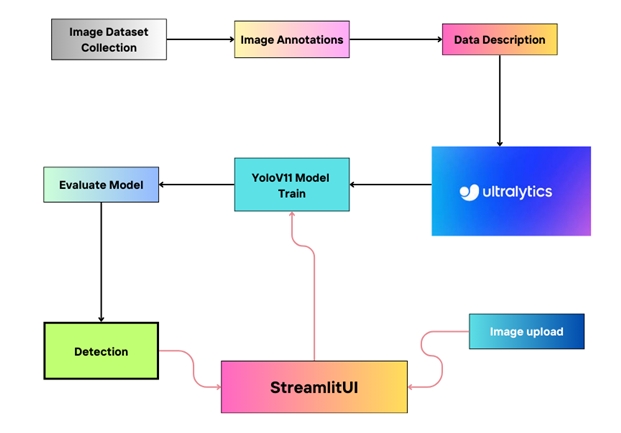Aim:
To develop a real-time fire and smoke detection system using the latest YOLOv11 model, providing higher accuracy and faster response in complex environments.
Abstract:
Fire incidents pose a significant threat to human life, property, and the environment. Traditional fire detection methods, such as smoke and heat sensors, often struggle with accuracy in complex scenarios. Recent advancements in computer vision and deep learning have introduced models like YOLOv8 for fire and smoke detection, offering improved results. However, limitations still exist regarding detection speed, accuracy in challenging environments, and false alarm rates. To address these challenges, our proposed system utilizes the latest YOLOv11 model, which enhances object detection capabilities with an improved feature extraction mechanism, multi-scale detection, and advanced attention modules. The system processes live video feeds, accurately detecting fire and smoke in real-time. Experimental results demonstrate a significant improvement in mean Average Precision (mAP) and detection speed compared to existing YOLOv8-based systems. This advancement can be a critical tool for enhancing safety in public spaces, industrial sites, and natural environments, contributing to faster emergency responses and reduced fire-related damages.
Introduction:
Fire disasters, both natural and man-made, have long-lasting impacts on human safety and environmental stability. Early detection of fire and smoke is crucial for minimizing losses and ensuring quick emergency responses. While traditional sensor-based systems provide basic fire detection, they often fail in dynamic environments with varying light and smoke conditions. Computer vision models, particularly those in the YOLO (You Only Look Once) series, have emerged as powerful tools for visual fire and smoke detection. The improved YOLOv8 model has shown promising results in identifying fire and smoke in complex scenarios. However, the need for higher accuracy, faster processing, and reduced false alarms drives the adoption of the more advanced YOLOv11 model in our proposed system.
Problem Definition:
Existing fire detection systems using YOLOv8, while effective, have limitations in detection accuracy, processing speed, and robustness in complex environments. These systems struggle with background interference, small object detection, and maintaining accuracy in low-light or smoky conditions. The lack of advanced feature extraction and limited attention mechanisms further hinder their performance. Our proposed system aims to overcome these challenges by integrating the YOLOv11 model, which offers enhanced feature extraction, multi-scale attention, and faster processing capabilities.
Existing System:
The existing fire and smoke detection system utilizes an improved YOLOv8 model, incorporating features such as a large target detection head, EMA (Efficient Multi-Scale Attention) module, and PAN-Bag structure. These enhancements improve detection in large-scale fire scenarios and complex backgrounds. However, the model’s sensitivity to background noise, limited detection range, and slower processing speed remain challenges.
Disadvantages of the Existing System:
The existing fire and smoke detection system based on the improved YOLOv8 model, while effective in many scenarios, has several limitations. One major drawback is its limited accuracy in complex and dynamic environments, where background interference can lead to higher false alarm rates and missed detections. The system’s sensitivity to lighting changes, smoke density variations, and complex backgrounds often results in misclassification or failure to detect fire and smoke accurately. Additionally, the YOLOv8 model’s processing speed may not be sufficient for real-time applications, especially in high-resolution video streams, causing delays in emergency response.
The model’s restricted detection range also hinders its ability to recognize small or distant fire and smoke instances, making it less reliable in large-scale surveillance areas such as forests or industrial sites. Furthermore, the existing approach may struggle with detecting fire through obstacles or in low-visibility conditions, which reduces its effectiveness in critical scenarios. The system’s dependency on specific environmental conditions also limits its adaptability and scalability across different deployment settings. These disadvantages highlight the need for an improved approach that can offer higher accuracy, faster processing, and robust performance in diverse and challenging environments.
Proposed System:
Our proposed system leverages the latest YOLOv11 model for enhanced fire and smoke detection. The YOLOv11 model features advanced attention mechanisms, improved multi-scale feature extraction, and faster object detection capabilities. It addresses the limitations of YOLOv8 by providing a broader detection range, higher accuracy, and robust performance in challenging environments. The system is designed for real-time surveillance, capable of processing live video feeds and providing instant alerts in case of fire or smoke detection.
Advantages:
The proposed system, utilizing the advanced YOLOv11 model, offers numerous advantages over existing fire and smoke detection methods. One of the key benefits is its significantly improved accuracy, achieved through enhanced multi-scale feature extraction and advanced attention mechanisms, which reduce false positives and false negatives. The system is designed for real-time processing, providing instant detection of fire and smoke in live video feeds, which is crucial for quick emergency responses. The robustness of the model in complex scenarios is a notable advantage, as it effectively handles background interference, low-light conditions, and dynamic environments.
The broader detection range of the YOLOv11 model allows for the identification of small or distant fire and smoke instances, making it suitable for large-scale surveillance applications such as forests, industrial sites, and urban areas. Additionally, the system’s scalability ensures that it can be easily integrated into existing surveillance infrastructures, enhancing safety measures across various environments. The integration of a real-time alert system further amplifies its utility by enabling immediate notification to emergency services, thereby reducing potential property damage and risks to human life. Overall, the proposed system not only improves detection speed and accuracy but also offers flexibility and reliability, making it a valuable tool for modern surveillance and safety applications





















Reviews
There are no reviews yet.